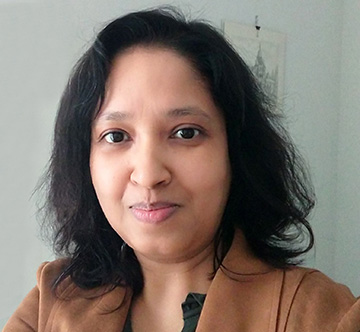
Saswatee Banerjee
In this installment of Senior Member Insights, OPN talks with Saswatee Banerjee, a senior optical scientist doing corporate research and development in Japan for the last 15 years. Since 2018, she has worked for Brillnics Japan Inc., leading the optical-simulation-based design of CMOS image sensor pixels. Her past work experience is mainly in designing and simulating optical components for liquid-crystal displays and organic LEDs.
Banerjee received Ph.D. degrees in applied physics, with specialization in optics, from the University of Calcutta, India, in 2001 and from the University of Tsukuba, Japan, in 2005. Her primary research interests are in design, simulation and analysis of optical devices and components that incorporate subwavelength-scale structural modulation. She has pioneered important advances in high-precision photonics computation techniques.
What first interested you in pursuing science?
The rationality and logical thinking associated with science inspired me to pursue this field. Science is data-driven, based on verifiable facts. Hence, it is easier to deduce a right answer.
What aspect of your current work do you find the most interesting or exciting?
My professional work in corporate R&D involves computer-aided simulation for the design of optical devices, such as CMOS image sensors, OLEDs and optical components for liquid-crystal-based displays. Good simulations can yield important physical insights into the workings of a device or component, guide experiments and thus reduce development costs. Real devices are very complicated, but we can make good approximate predictions of their optical characteristics by extracting their essential elements. Building a good model of the device under consideration holds the key to good simulations.
For me, the most interesting parts are coming up with a design flow, developing a simulation method, building a good model for simulation, and finally analyzing and interpreting the simulation results.
What tips for successful networking do you have for early-career professionals?
Personally, I networked with many people at professional conferences and seminars. Platforms like LinkedIn are also effective for successful networking.
What professional resources do you rely on to stay active and engaged with your field?
Scientific publications, conferences, and journal papers. I get access to many scientific and technical articles through my membership in professional organizations, such as OSA, SPIE, IEEE and SID. I attend scientific webinars regularly in my field.
What’s the best career decision you’ve ever made, and why?
The best career decision for me was to opt for applied physics. I also chose optics specialization. When I began my Master’s program, one of our professors told us as applied physicists, we did not need to chase jobs; opportunities will find us. In my career, I got many opportunities. Training in applied physics is about being able to solve real-life problems using scientific principles.
Describe a major turning point in your career. Was there a specific action/accomplishment that got you there?
A major turning point was when I left my home country to come to Japan on a Japanese government scholarship. At first, it was a great challenge to learn the language, understand the culture, and cope with a different lifestyle. This experience has enhanced my professional creativity and broadened my thinking. Coming to Japan and staying and working here professionally for the last twenty years has significantly influenced my career path. Today, I am a global citizen with professional connections in India, Japan and the United States.
What is one piece of advice that you wish you were given as a student/early in your career?
The need to be a good communicator. In my career, I realized that it is not enough to come up with a good idea. It is also important to communicate ideas and implementations confidently and in a clear, understandable way that people from other disciplines can comprehend. This is important since, in most organizations, experts with different backgrounds need to collaborate and cooperate.
How important are leadership roles in career development, and how do you hone your leadership skills?
It might depend on an individual’s idea of career growth. Mentoring is a great way to hone one’s leadership skills. In the past, I had an intern working on my project for a month. I had to work very hard to prepare schedules, plans, presentations explaining the work, computer programs. I explained, instructed and monitored her daily. The outcome was positive. My intern did a good job, and my co-workers praised my effort.
When a junior employee recently joined our team, I trained her and taught her to follow my work. This process taught me how to explain complex technical issues and make it interesting to juniors who might not necessarily share the same background as mine. Now she appreciates the significance of the project and wants to continue working with me. However, it can also take a lot of time, especially in the beginning. It can take time out of your own work, be frustrating, and not always a smooth ride. But at the end of the day, it is a rewarding experience.
At this point in your career, what are you most looking forward to next?
I want to build my own team that focuses on design, simulation, algorithm development in optics. At my present job, a junior engineer is assisting me in carrying out my design/simulation plans.
If you weren’t in the sciences, what would be your dream career?
I chose optics because I am attracted to color as in nature or art, or fashion. I am also enthusiastic about photography. My second career could be in nature photography or as an artist dealing with colors and shapes.
